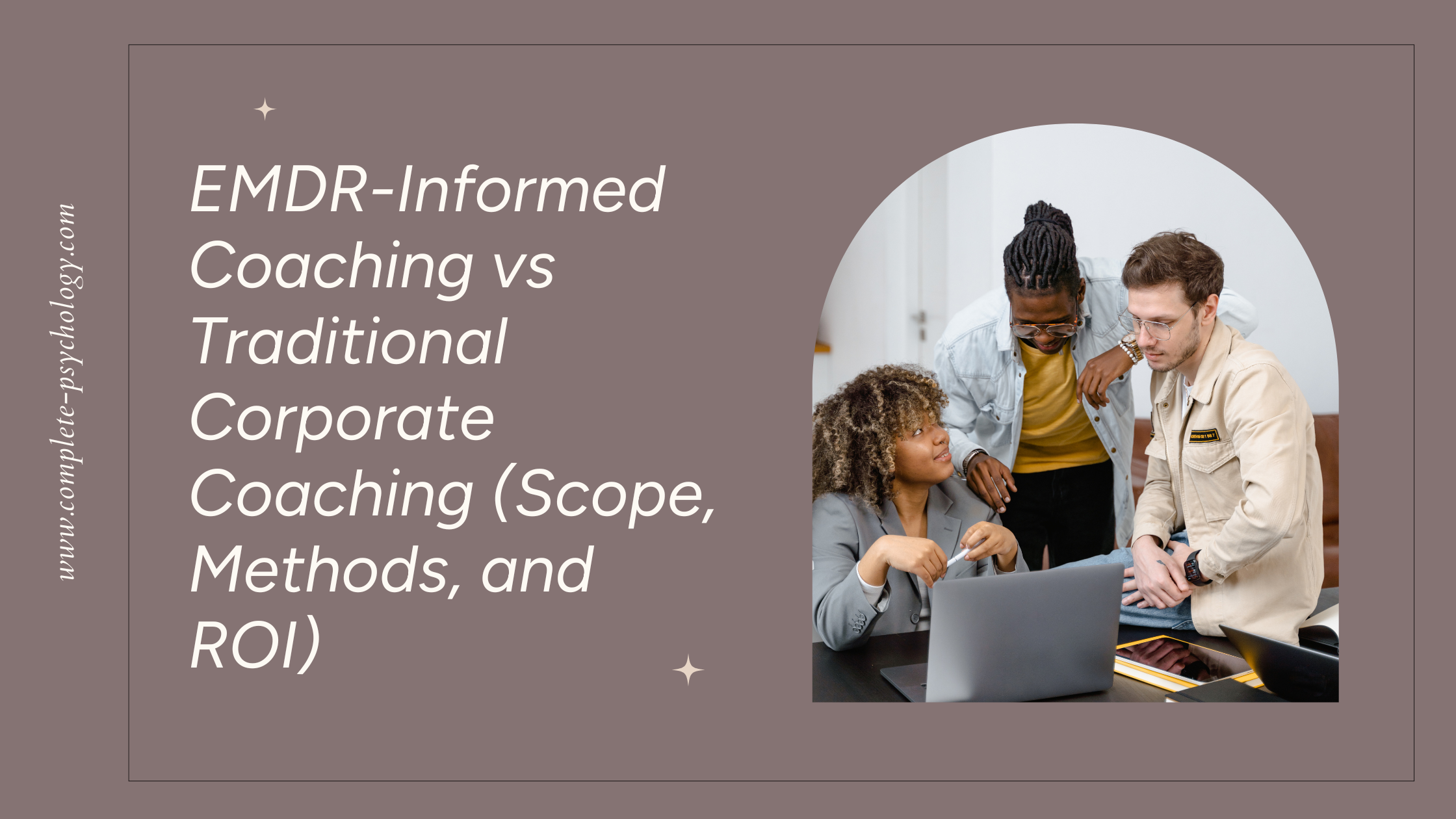
What if the block that keeps you stuck is not a skill gap, but a stress loop your body keeps replaying? EMDR-informed coaching targets those loops so you can perform with a clear head. It borrows methods from EMDR therapy, like bilateral stimulation and nervous system regulation, to help you process stuck patterns tied to stressful memories or negative beliefs, while staying within the scope of coaching.
By contrast, traditional corporate coaching is goal driven. It uses models like GROW and SMART goals, plus feedback and practice, to build skills, habits, and performance. Think plans, reps, and accountability.
Scope matters. EMDR-informed coaching is not therapy. It does not diagnose, treat, or process trauma in depth. It supports performance and well-being at work. Complex trauma belongs with a licensed therapist.
This guide helps HR leaders, L&D partners, team leads, and driven professionals who want faster, deeper change, or a safer path when topics feel sensitive. You will learn the core differences, what sessions look like, when to choose each approach, how to measure ROI, and how to pick a qualified coach. Keywords to watch trauma-informed coaching, performance coaching, public speaking anxiety, burnout, and ROI in coaching.
Core differences at a glance: scope, method, and goals
What EMDR-informed coaching is and is not
EMDR uses bilateral stimulation, such as eye movements, hand taps, or tones, to help the brain reprocess stuck memories and/or beliefs. In coaching, these methods support two things: downshifting the nervous system and updating how current triggers feel and land.
Common elements adapted for coaching:
Boundaries keep it safe. The focus stays on today’s performance and resilience, not on trauma treatment. Coaches get consent, watch for signs of distress, and refer to therapy if deeper issues appear. Clear scope language, session pacing, and opt out options are key.
What traditional corporate coaching focuses on
Corporate coaching starts with discovery. You map values, strengths, and goals tied to the business. Common tools include:
The aim is to improve leadership behaviours, influence, and delivery. The result shows up in projects shipped, meetings led, and teams aligned.
Key differences that shape results at work
How the methods work in real sessions
Picture two paths to the same hilltop. One quiets the noise inside you, so the climb feels lighter. The other gives you a better map, boots, and a training plan. You can choose one or use both.
Session flow in EMDR-informed coaching
Work stays job focused. Targets are chosen for relevance and safety. Sessions are contained, usually 45 to 60 minutes.
Session flow in traditional corporate coaching
The rhythm builds momentum. The coach guides reflection, sharpens plans, and celebrates wins.
When to choose which approach for common work challenges
Pick the method that fits the problem. Skills and plans build speed. Nervous system work removes friction.
Public speaking nerves and performance anxiety
EMDR-informed coaching can reduce a racing heart and shaky hands that trace back to a bad pitch or a harsh comment. After the charge drops, rehearse a calm, clear speech with bilateral stimulation to lock in the new state.
Traditional coaching sharpens the story, builds slides that guide the audience, plans practice reps, and sets feedback loops. Use both to speak better and feel better.
Burnout, stress, and emotional triggers
EMDR-informed coaching lowers reactivity to cues like urgent emails or a sharp tone. You build self-regulation, so you recover faster after spikes.
Corporate coaching addresses workload, boundaries, and calendar habits. You adjust meetings, set rules for after hours, and get support from your manager. If symptoms point to clinical burnout or depression, pause coaching, and refer to a licensed therapist.
Imposter syndrome and leadership blocks
EMDR-informed coaching targets sticky beliefs, such as I am not ready, that show up as tightness in the chest or a spiral of doubt. Install I can learn as I lead, then rehearse key moments like a board update.
Traditional coaching builds visible wins. You secure a sponsor, collect proof points, and request targeted feedback. Confidence grows from results plus inner shifts.
Team conflict and culture issues
EMDR-informed coaching helps a leader stay calm and clear when a meeting gets heated. With more control in the moment, better words come easier.
Traditional coaching adds conflict skills, meeting structures, and scripts for hard talks. If the issue sits across a whole team, consider facilitation, training, or mediation.
Outcomes, ROI, and choosing the right coach
Results matter. Tie methods to outcomes you can track, then buy with care.
How to measure impact and ROI
Use simple before and after metrics:
Run pre and post self-ratings, add manager input, and review at 6 to 12 weeks.
Credentials and training to look for
Program design, cost, and access
Pricing varies by market and experience. For HR, run a pilot, define outcomes, and set secure data handling from day one.
Blending both approaches for best results
A smart hybrid often works best. Stabilize the nervous system first, process one key trigger, then shift to skills, habits, and stakeholder work. If needs change, build a referral path between coach and therapist. Keep scope clear and goals visible.
Conclusion
EMDR-informed coaching helps resolve sticky, trigger-based blocks in the body and mind, traditional corporate coaching builds skills, plans, and accountability. Used well, both drive strong results. Start with clear goals, choose based on what is in the way, and measure progress with simple metrics. If you want a safer path for sensitive topics, EMDR-informed coaching can be a smart first step. Ready to explore the best fit? Talk with a coach and map your next move.
© Complete Psychology | Cookie Policy | Privacy Policy | Terms and Conditions